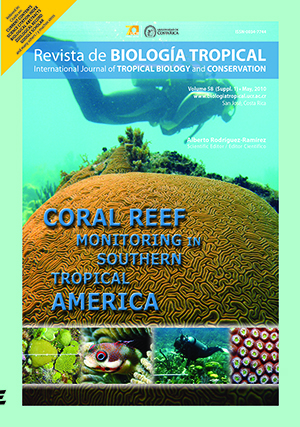Abstract
In spite of their economic importance, coral reef communities of the world are rapidly decreasing, and an adequate management planification is needed . The benthic and fish communities of Dos Mosquises Sur and Madrizquí at Los Roques National Park, and Caiman and Cayo Norte at Morrocoy National Park, in Venezuela were monitored during 2003 and 2004. The CARICOMP method was used to describe the benthic community, and the AGRRA protocol was applied to the fish community assessment. The benthic cover of five broad living categories (i.e. corals, algae, sponge and octocorals) differed across the sites (Nested ANOVA, p < 0.05), but there were no statistical differences between parks. Despite being on different parks, the benthic cover in Dos Mosquises Sur and Cayo Norte was similar (76% based on Bray-Curtis), whereas Caiman differed greatly (57- 68%) from all other sites. The cover of hard coral, algae, sponges and octocorals was similar between 2003 and 2004 in all four sites. Similarly, the fish community structure of both parks did not change over time, and was dominated by herbivores (Pomacentridae, Scaridae and Acanthuridae). However, commercially important carnivores (e.g. Lutjanids and Serranids) were more abundant in Los Roques than in Morrocoy. Although it was expected that the benthic cover and fish community would reflect greater differences between Los Roques and Morrocoy, only the fish community appeared healthier in Los Roques, whereas Cayo Norte (Morrocoy), had a coral cover similar or higher than both sites of Los Roques. Thus, our results suggest that in Venezuela, oceanic reef sites are not necessarily ‘healthier’ (i.e. higher coral cover) than land-influenced coral communities. The addition of three new sites and the reincorporation of Caiman has improved and expanded the monitoring capabilities in Venezuela and it represents the first step towards the consolidation of a coral reef monitoring program for the country.##plugins.facebook.comentarios##

This work is licensed under a Creative Commons Attribution 4.0 International License.
Copyright (c) 2010 Revista de Biología Tropical
Downloads
Download data is not yet available.






